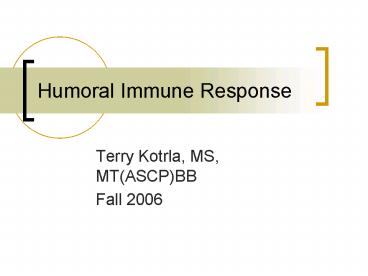Humoral Immune Response - PowerPoint PPT Presentation
1 / 34
Title:
Humoral Immune Response
Description:
Gamma. Delta. Alpha. Mu. Epsilon. Basic Antibody Structure. Two identical light chains. Kappa OR ... Gamma heavy chains. Found intravascularly AND extravascularly ... – PowerPoint PPT presentation
Number of Views:569
Avg rating:3.0/5.0
Title: Humoral Immune Response
1
Humoral Immune Response
- Terry Kotrla, MS, MT(ASCP)BB
- Fall 2006
2
Humoral Immunity
- Results in production of proteins called
immunoglobulins or antibodies. - Body exposed to foreign material termed
antigen which may be harmful to body virus,
bacteria, etc. - Antigen has bypassed other protective mechanisms,
ie, first and second line of defense.
3
Dynamics of Antibody Production
- Primary immune response
- Latent period
- Gradual rise in antibody production taking days
to weeks - Plateau reached
- Antibody level declines
4
Dynamics of Antibody Production
- Antibody production
- Initial antibody produced in IgM
- Lasts 10-12 days
- Followed by production of IgG
- Lasts 4-5 days
- Without continued antigenic challenge antibody
levels drop off, although IgG may continue to be
produced.
5
Secondary Response
- Second exposure to SAME antigen.
- Memory cells are a beautiful thing.
- Recognition of antigen is immediate.
- Results in immediate production of protective
antibody, mainly IgG but may see some IgM
6
Humoral Immune Response
7
Dynamics of Antibody Production
8
Cellular Events
- Antigen is processed by T lymphocytes and
macrophages. - Possess special receptors on surface.
- Termed antigen presenter cell APC.
- Antigen presented to B cell
9
Basic Antibody Structure
- Two identical heavy chains
- Gamma
- Delta
- Alpha
- Mu
- Epsilon
10
Basic Antibody Structure
- Two identical light chains
- Kappa OR
- Lambda
11
Basic Antibody Structure
12
Basic Structure of Immunoglobulins
13
Papain Cleavage
- Breaks disulfide bonds at hinge region
- Results in 2 fragment antigen binding (Fab)
fragments. - Contains variable region of antibody molecule
- Variable region is part of antibody molecule
which binds to antigen.
14
Papain Cleavage
15
Pepsin
- Breaks antibody above disulfide bond.
- Two F(ab)2 molecules
- The rest fragments
- Has the ability to bind with antigen and cause
agglutination or precipitation
16
Papain and Pepsin Cleavage
17
IgG
- Most abundant
- Single structural unit
- Gamma heavy chains
- Found intravascularly AND extravascularly
- Coats organisms to enhance phagocytosis
(opsonization)
18
IgG
- Crosses placenta provides baby with immunity
for first few weeks of infants life. - Capable of binding complement which will result
in cell lysis - FOUR subclasses IgG1, IgG2, IgG3 and IgG4
19
IgG
20
IgA
- Alpha heavy chains
- Found in secretions
- Produced by lymphoid tissue
- Important role in respiratory, urinary and bowel
infections. - 15-10 of Ig pool
21
Secretory IgA
- Exists as TWO basic structural units, a DIMER
- Produced by cells lining the mucous membranes.
22
Secretory IgA
23
IgA
- Does NOT cross the placenta.
- Does NOT bind complement.
- Present in LARGE quantities in breast milk which
transfers across gut of infant.
24
IgM
- Mu heavy chains
- Largest of all Ig PENTAMER
- 10 of Ig pool
- Due to large size restricted to intravascular
space. - FIXES COMPLEMENT.
- Does NOT cross placenta.
- Of greatest importance in primary immune response.
25
IgM
26
IgE
- Epsilon heavy chains
- Trace plasma protein
- Single structural unit
- Fc region binds strongly to mast cells.
- Mediates release of histamines and
heparingtallergic reactions - Increased in allergies and parasitic infections.
- Does NOT fix complement
- Does NOT cross the placenta
27
IgE
28
IgD
- Delta heavy chains.
- Single structural unit.
- Accounts for less than 1 of Ig pool.
- Primarily a cell bound Ig found on the surface of
B lymphocytes. - Despite studies extending for more than
4 decades, a specific role for serum IgD has not
been defined while for IgD bound to the membrane
of many B lymphocytes, several functions have
been proposed. - Does NOT cross the placenta.
- Does NOT fix complement.
29
Cellular Immune Response
- Important in defending against fungi,
parasites, bacteria. - Responsible for hypersensitivity, transplant
rejection, tumor surveillance. - Thymus derived (T) lymphocytes
30
Cell Mediated Reaction
- Helper T cells turn on immune response
- Suppressor T cells turn off immune response
- Cytotoxic T cells directly attack antigen
31
Cell Mediated Immunity
32
Lymphokines
33
Summary
- http//www.biology.arizona.edu/immunology/tutorial
s/immunology/page2.html
34
- http//www.jdaross.cwc.net/humoral_immunity.htm
- http//academic.brooklyn.cuny.edu/biology/bio4fv/p
age/aviruses/cellular-immune.html - http//www.uic.edu/classes/bios/bios100/lecturesf0
4am/lect23.htm

